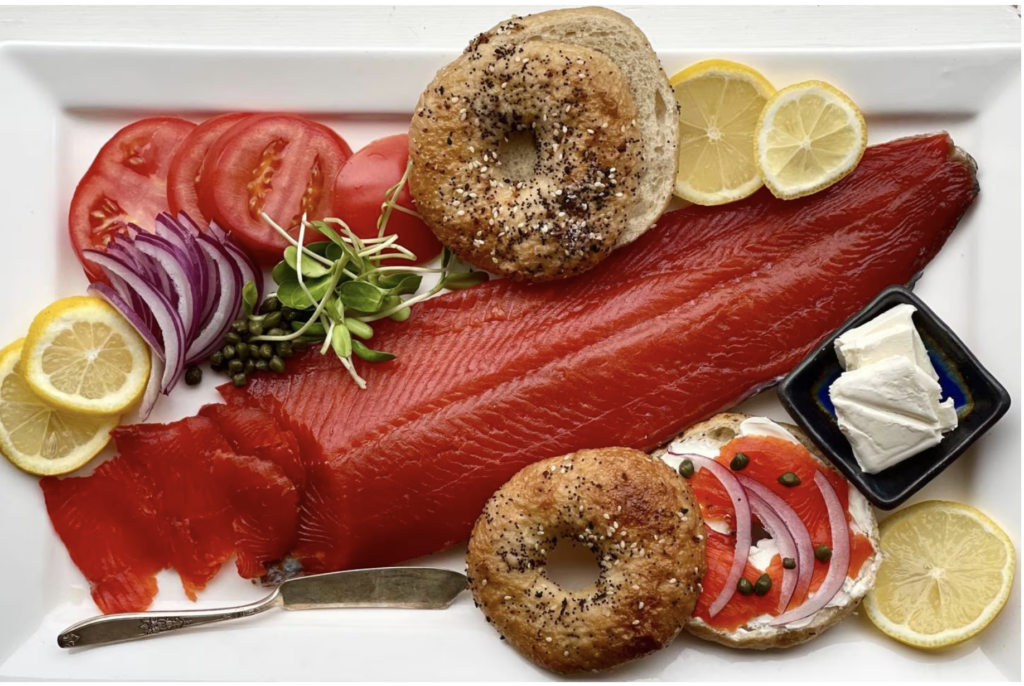Toward the end of last summer, Juneau Chef Beau Schooler sent me his epic gin lox recipe on the same day my friend Nathaniel brought me a fresh silver salmon. Kismet! The resulting lox had a refreshing gin-and-tonic flavor — bright, herbal, citrusy — a love sonnet to a toasted bagel with cream cheese.
We’ve been waiting almost a year to share it, for when the state is awash in fresh fish. Important: You cannot make these lox with frozen fish. (You can, though, freeze the fish after you cure it, if you are concerned about parasites.) As a person who spent an entire summer testing smoked salmon recipes, the best part about lox: They are so easy. You mix a cure, slide the salmon in, and let it do its thing. You do have to turn it once. Ask me how I know now to set my cellphone to remind me.
This recipe uses local gin, juniper berries — or in Beau’s case, spent gin botanicals from his neighbors at Amalga Distillery in Juneau — and lemon zest. Since Alaska has a number of distilleries, it’s nice to use local gin. An herbal gin — like Hendrick’s or Juneauper Gin by Amalga, which uses spruce tip, devil’s club, Labrador tea and rhubarb botanicals — imparts the most complex flavor. You can get juniper berries in Anchorage at Summit Spice & Tea Co. For this recipe, you’ll toast them lightly in a pan over medium heat until they get shiny and release their oils, then you’ll want to crush them well with a mortar and pestle or in a plastic bag with a rolling pin. You can use kosher or fine sea salt for the brine, but don’t use table salt.
You do have to prep the fish by thoroughly removing bones. Do this gently, so as not to rip the flesh too much. A really good tool helps. I’m a proponent of the hemostat clamp, which is used for medical purposes and fly-tying. They’re about $4 on Amazon. Expose the line of bones on the fillet by running your finger gently along the flesh toward the tail. Pull bones following the angle they are pointing and try not to press on the meat while you’re doing it. A salmon usually has 20-30 pin bones per side. I try to find and pull at least 25.
Beau says the lox can be vacuum-sealed and stored a couple weeks in the fridge or a couple months in the freezer. Make sure you have a very sharp knife for slicing them, the thinner the better. I have the best luck using a very sharp, flexible medium paring knife.
Beau Schooler’s Gin Lox
Ingredients:
1 1/2 pound fresh salmon fillet, pin bones removed, skin on
1/3 cup kosher or fine sea salt
1/3 cup sugar
Zest of one lemon
1 tablespoon juniper berries, lightly toasted in a pan, thoroughly crushed
1 ounce gin, preferably Amalga Distillery gin or gin from another local distillery you support.
Method:
In a small mixing bowl combine the salt, sugar, lemon zest, and crushed juniper berries. Mix well, then add the gin and mix some more until the mixture has the consistency of damp sand. Set aside.
Get a glass baking dish or other tall edged, flat-bottomed container that is slightly larger than your salmon fillet. You want the fish to lay flat and you don’t want the cure to pool up. Sprinkle a little bit of the cure on the bottom of the container. Take the salmon fillet and place it skin side down in the container. Pour the remaining cure over the salmon and then gently massage it into the flesh. Cover the container and set it in the fridge overnight, at least eight hours.
The next morning, the cure should have mostly melted and turned into a brine. Take any unmelted cure and rub it back into the fillet, then flip the fillet over, with the skin side now up. Cover and return to the fridge.
After 18 hours, start checking your lox for doneness. The skin should be shiny, tight, and slightly wrinkled. The flesh should feel firm, with a deeper red color than when you started. If it hasn’t firmed up, splash some more of the melted cure brine on it and return it to the fridge, check again in another couple hours.
When the lox feels finished, remove it from the cure and quickly rinse it under cold water, removing any remaining cure. Place the lox on a plate covered in a paper towel. Place another paper towel on top and gently dry it as much as possible. Place the lox, uncovered, in the fridge to air dry for a couple hours.
Slice very thin with a sharp knife, starting at the wide side of the fillet and cutting on the bias toward the tail. Enjoy.
